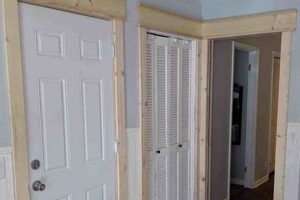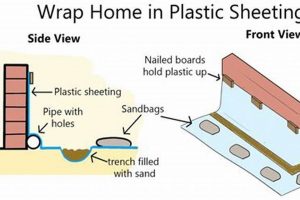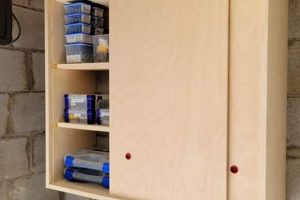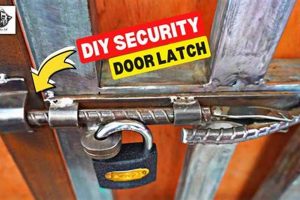Addressing faults in residential overhead access systems without professional assistance involves various methods, often aimed at cost reduction and immediate problem resolution. This encompasses tasks ranging from lubricating components and tightening bolts to replacing rollers or adjusting spring tension.
Undertaking such projects allows homeowners to save money on labor costs and gain a better understanding of their door’s mechanics. Historically, many have preferred this route, driven by a desire for self-sufficiency and immediate control over their property’s maintenance. However, safety and proper execution are paramount due to the complex and potentially hazardous nature of garage door systems.
The following sections will delve into specific aspects of diagnosing common malfunctions, identifying necessary tools and materials, and outlining safe and effective procedures for performing relevant maintenance and replacement tasks.
Essential Guidance for Garage Door Maintenance Without Professional Help
The following recommendations are designed to equip individuals with the fundamental knowledge required to maintain a residential overhead door system independently. Prioritize safety and accuracy in all procedures.
Tip 1: Prioritize Safety. Disconnect the opener unit from its power source before commencing any work. Utilize safety glasses and work gloves to mitigate potential injury.
Tip 2: Conduct Visual Inspections Regularly. Examine springs, cables, rollers, and tracks for signs of wear, damage, or misalignment. Early detection prevents escalation of problems.
Tip 3: Lubricate Moving Parts. Apply a silicone-based lubricant to rollers, hinges, and springs every three to six months. This reduces friction and prolongs component life.
Tip 4: Tighten Loose Hardware. Periodically inspect and tighten bolts, nuts, and screws on tracks, hinges, and the opener unit. Vibration can cause loosening over time.
Tip 5: Test Balance. Disengage the opener and manually lift the door halfway. It should remain in place. If it rises or falls, spring tension adjustment is necessary, ideally performed by a qualified technician.
Tip 6: Clear Obstructions. Ensure the tracks are free from debris, such as dirt, leaves, or small objects. Obstructions can impede smooth operation and damage the system.
Tip 7: Inspect Weather Stripping. Replace damaged or deteriorated weather stripping around the door’s perimeter to maintain energy efficiency and prevent water intrusion.
Adhering to these principles facilitates proactive care of residential overhead access systems, potentially averting significant repairs and extending the door’s operational lifespan.
The succeeding sections will explore advanced maintenance procedures and when professional assistance becomes imperative.
1. Safety Precautions
The intersection of safety protocols and residential overhead door maintenance without professional assistance represents a critical juncture. Failure to observe stringent safety measures during independent repair attempts can precipitate severe injury or even fatality. The inherent danger stems from the high-tension springs, considerable weight of the door, and potential for electrical hazards within the opener mechanism. A primary example of this risk is spring replacement; improperly handled, a torsion spring can release with enough force to cause significant physical trauma. Similarly, neglecting to disconnect the power supply before working on the opener can lead to electrocution.
Adequate safety measures function as a preventative barrier against these risks. Such protocols should encompass the use of appropriate personal protective equipment, including safety glasses and work gloves, ensuring the door is properly supported to prevent uncontrolled descent, and employing suitable tools for the task. Furthermore, recognizing personal limitations and deferring complex repairs, such as spring replacement, to qualified professionals, constitutes a vital aspect of safety consciousness. Instances of garage door-related injuries often trace back to a lack of awareness of these dangers and inadequate adherence to fundamental safety procedures.
In summation, integrating robust safety practices into residential overhead door maintenance without professional assistance is not merely advisable but mandatory. Comprehending the potential hazards, employing appropriate protective measures, and acknowledging limitations are crucial determinants of a safe and successful outcome. The alternative carries a heightened risk of serious injury and underscores the importance of prioritizing safety above all else.
2. Component Inspection
Component inspection is a cornerstone of successful residential overhead access system maintenance without professional intervention. The efficacy of any repair effort hinges on the accurate identification of the underlying problem. This process involves a systematic examination of all critical elements, including springs, cables, rollers, tracks, hinges, and the opener unit itself. For instance, a door that struggles to open might stem from a worn-out roller, a frayed cable, or a misaligned track. Without a thorough inspection, one might incorrectly assume the problem lies with the opener, leading to unnecessary replacements and continued malfunction.
The absence of diligent component inspection often results in misdiagnosis and ineffective repairs. For example, neglecting to examine the springs can lead to overlooking a critical break, which can cause the door to crash down unexpectedly, posing a safety hazard. Conversely, a detailed inspection might reveal that simple lubrication or tightening of bolts is sufficient to resolve the issue, precluding the need for more extensive and costly interventions. A real-world instance could involve a homeowner who attributed a noisy door to a faulty opener, only to discover, after inspection, that the rollers were worn and square, causing the noise. Replacing these rollers restored smooth and quiet operation.
In summary, component inspection represents a crucial prerequisite for residential overhead access system maintenance without professional assistance. It forms the basis for accurate problem identification, informs appropriate repair strategies, and ultimately contributes to the longevity and safe operation of the door. While the knowledge and tools to perform the actual repairs are important, the ability to thoroughly and accurately assess the condition of each component ensures the efficiency and effectiveness of these efforts. This approach minimizes wasted time and expense while maximizing the safety and functionality of the garage door system.
3. Lubrication Frequency
The relationship between lubrication frequency and the successful execution of residential overhead access system maintenance by non-professionals is a directly proportional one. Infrequent lubrication introduces increased friction among moving parts, leading to premature wear, operational inefficiency, and potentially, component failure. This can manifest as a door that operates sluggishly, makes excessive noise, or experiences a shortened lifespan. Consider rollers; when deprived of regular lubrication, they experience increased friction against the track, accelerating wear and eventually resulting in deformation or breakage. This necessitates component replacement, a task that can be avoided or delayed with consistent lubrication.
A practical example illustrates this point: a homeowner neglecting routine lubrication might observe a garage door becoming progressively louder and harder to open over time. The cause could be dried-out hinges and rollers, increasing the force required from the opener motor. This elevated strain can subsequently damage the opener, transforming a minor maintenance oversight into a more substantial and expensive repair. A scheduled lubrication program using a silicone-based lubricant mitigates such risks. Furthermore, proper lubrication assists in preventing corrosion, especially in environments with high humidity or exposure to de-icing salts. Lubrication schedules should vary based on the usage frequency and environmental conditions, generally ranging from every three to six months.
In conclusion, appropriate lubrication frequency is not merely an ancillary task but a fundamental component of maintaining residential overhead access systems without professional intervention. Adherence to a regular lubrication schedule directly impacts the lifespan, operational efficiency, and safety of the door system. The challenges primarily revolve around establishing and maintaining a consistent schedule. Overcoming this requires integrating lubrication into a routine home maintenance checklist. Ignoring lubrication frequency can lead to preventable repairs and highlights the significance of proactive maintenance.
4. Hardware Tightening
Hardware tightening represents a fundamental, often overlooked, aspect of maintaining residential overhead access systems without professional assistance. The operational forces and vibrations inherent in garage door usage inevitably cause fasteners bolts, nuts, screws to loosen over time. This loosening compromises the structural integrity and functionality of the entire system. A direct consequence of neglected hardware tightening is the gradual misalignment of tracks, hinges, and other critical components, leading to erratic door movement, increased strain on the opener mechanism, and potentially, complete system failure. An example is the gradual loosening of track bolts. These can cause the door to bind and struggle to open or close properly, potentially causing the opener to malfunction or the door to come off its tracks.
Effective hardware tightening involves a systematic inspection of all accessible fasteners, followed by the application of appropriate torque using suitable tools. It is crucial to use the correct size and type of wrench or screwdriver to avoid stripping the fastener heads, and avoid overtightening, which can also cause damage. A practical application is regularly checking the hinge bolts that attach the door panels to the hinges. Loose hinge bolts cause the door panels to sag. Tightening these prevents excessive wear on the rollers and tracks, and maintains a good door seal. Employing thread-locking compounds on critical fasteners can offer additional security against loosening due to vibration. This is particularly advisable in systems subjected to heavy use or those located in areas prone to seismic activity.
In summary, regular hardware tightening forms a crucial preventative measure within the scope of residential overhead access system maintenance without professional assistance. Its consistent application mitigates the risks of component misalignment, operational inefficiencies, and potentially catastrophic failures. Challenges arise from the need for specialized tools and the identification of critical fasteners, and requires patience. Overcoming such challenges necessitates access to reliable resources detailing proper hardware configurations, thread lock, and torquing. Neglecting this simple yet vital procedure can have considerable consequences, emphasizing the practical significance of incorporating hardware tightening into a regular maintenance routine.
5. Balance Assessment
Balance assessment constitutes a critical diagnostic procedure within the realm of residential overhead access system maintenance conducted without professional assistance. This assessment verifies the correct interplay between the door’s weight and the spring tension, ensuring safe and efficient operation. An imbalanced system places undue stress on the opener mechanism, accelerates component wear, and presents a significant safety hazard.
- Identifying Imbalance Indicators
Recognizing signs of imbalance is paramount. These include the door’s inability to remain stationary at mid-height when manually operated, abrupt or jerky movements, or excessive strain evident in the opener’s operation. For example, if a door rises rapidly upon disengagement from the opener, excessive spring tension is indicated. Conversely, a door that immediately falls suggests insufficient spring tension. Early identification allows for timely corrective action, potentially preventing further damage.
- Manual Operation Testing
The most direct balance assessment involves manually operating the door after disengaging it from the opener. A properly balanced door should require minimal effort to raise or lower, and should hold its position at various points along its travel. If significant force is required or the door exhibits a tendency to drift upwards or downwards, imbalance is confirmed. This test provides a tangible indication of the system’s mechanical state.
- Spring Tension Evaluation
Assessing spring tension indirectly involves examining the springs for signs of damage, corrosion, or improper positioning. While direct spring adjustments are typically reserved for professionals due to safety concerns, a visual inspection can reveal obvious issues. For instance, a broken or significantly corroded spring is a clear indication of compromised balance. Observing the positioning of the springs, ensuring they are correctly seated and aligned, also contributes to the assessment.
- Safety Implications of Imbalance
An imbalanced residential overhead access system poses significant safety risks. A door with excessive spring tension can unexpectedly slam shut, causing injury or property damage. Conversely, a door with insufficient spring tension might require excessive force to operate, increasing the risk of manual handling injuries. These risks underscore the importance of accurate balance assessment and, when necessary, professional intervention to restore proper balance.
These facets collectively underscore the importance of balance assessment in ensuring the safety, longevity, and efficient operation of residential overhead access systems. Recognizing imbalance indicators, performing manual operation tests, evaluating spring tension, and acknowledging the inherent safety implications allows individuals engaged in maintenance without professional assistance to make informed decisions regarding system repair and, when necessary, seeking expert help.
6. Obstruction Removal
Obstruction removal is inextricably linked to the successful execution of residential overhead access system maintenance without professional intervention. The presence of obstructions within the door’s operational path directly impedes its intended function, causing strain on the mechanical components and potentially leading to significant damage. The root cause of these obstructions varies, ranging from accumulated debris within the tracks to misplaced objects interfering with the door’s descent. A garage door obstructed during operation often experiences increased resistance, forcing the opener motor to work harder, accelerating wear, and possibly causing premature failure. Consequently, ensuring the operational path remains clear is a crucial preventative measure within a residential overhead door’s care.
The practical significance of obstruction removal extends beyond preventing mechanical damage. A blocked safety sensor beam, for example, inhibits the door from closing, effectively rendering the system inoperable and compromising security. Correcting this issue often involves a simple clearing of the sensor’s line of sight. Neglecting such obstruction removal can be costly, leading to emergency service calls when a minor task would have sufficed. Regular track cleaning, performed with appropriate tools and care, prevents the buildup of dirt and debris that can impede roller movement. Likewise, ensuring that the area beneath the door’s path is free from obstacles safeguards against damage to the door panel’s lower edge and prevents injury to individuals or property during operation.
In summary, consistent obstruction removal is a foundational element of the maintenance of residential overhead access systems without professional intervention. Addressing this, individuals engaged in door maintenance safeguard the system against mechanical stress and potential failure. Prioritizing clear operational pathways is vital for overall system health. Despite being a relatively simple task, its consistent execution contributes significantly to the longevity, safety, and reliable function of the door. Proper tools and techniques will help in the task.
Frequently Asked Questions Regarding DIY Garage Door Repair
The following represents a compilation of frequently asked questions pertaining to residential overhead access system maintenance conducted independently. These responses are intended to provide clear, concise information on common concerns and misconceptions.
Question 1: What are the most critical safety precautions when attempting residential overhead door repairs without professional assistance?
Disconnecting the power to the opener unit is paramount. Utilizing safety glasses and work gloves reduces the risk of injury. Refraining from attempting spring replacement without specialized training and tools is essential.
Question 2: How frequently should a residential overhead door system be lubricated?
Lubrication frequency depends on usage and environmental conditions. Generally, moving parts should be lubricated every three to six months with a silicone-based lubricant.
Question 3: What tools are typically required for basic residential overhead door maintenance?
Essential tools include a set of wrenches, screwdrivers, pliers, a hammer, safety glasses, work gloves, and a silicone-based lubricant. A level and measuring tape are also beneficial.
Question 4: How is the balance of a residential overhead door system assessed?
The opener unit should be disengaged. Manual operation of the door is required. A properly balanced door should remain stationary at mid-height. If it drifts upward or downward, spring adjustment is necessary.
Question 5: When is it absolutely necessary to seek professional assistance for residential overhead door repairs?
Spring replacement, cable repair, and any work involving high-voltage electrical components should be performed by qualified technicians. Attempting these tasks without proper expertise is dangerous.
Question 6: What are common signs that a residential overhead door system requires maintenance?
Common indicators include noisy operation, jerky movements, difficulty opening or closing, visible signs of wear or damage on components, and a door that fails to remain balanced.
Proper maintenance of residential overhead doors is of vital importance.
The next section will address advanced troubleshooting.
DIY Garage Door Repair
This examination of “diy garage door repair” has outlined the essential knowledge, procedures, and safety precautions necessary for independent maintenance of residential overhead access systems. It emphasizes that such endeavors demand a thorough understanding of mechanical principles, a commitment to rigorous safety protocols, and the ability to accurately assess the condition of system components. Tasks such as lubrication, hardware tightening, and obstruction removal contribute significantly to the longevity and smooth operation of the door. However, more complex repairs, particularly those involving springs and cables, are fraught with danger and typically exceed the capabilities of untrained individuals.
Therefore, homeowners considering “diy garage door repair” must weigh the potential cost savings against the inherent risks. Prudence dictates that professional assistance be sought when facing unfamiliar or complex challenges. Neglecting this advice can lead to property damage, physical injury, or even fatality. The information presented herein serves as a guide for responsible decision-making, underscoring the importance of prioritizing safety and expertise when dealing with these critical systems.







